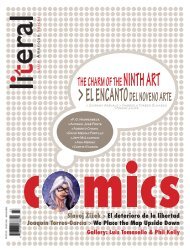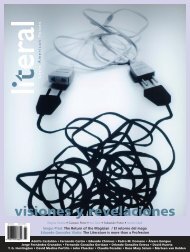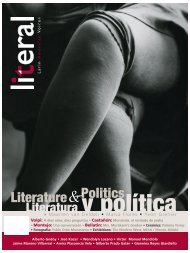Primo Jim Tanya Huntington Hyde - Literal
Primo Jim Tanya Huntington Hyde - Literal
Primo Jim Tanya Huntington Hyde - Literal
You also want an ePaper? Increase the reach of your titles
YUMPU automatically turns print PDFs into web optimized ePapers that Google loves.
The Girl and The Shoe, 1949. Cemetery of Tatuapé, São Paulo<br />
a movement that advocated an end to fi gurative<br />
(representational) art and promoted an<br />
objective art that pointed only to itself. It was<br />
also an art with the social mission of making<br />
art accessible to people’s lives as designs for<br />
modern living. Some Concrete artists de-romanticized<br />
the role of the artist and regarded<br />
themselves as mere workers. They also saw<br />
their vision of art as a timely one vis-à-vis<br />
Brazil’s ongoing modernization. Geraldo became<br />
a prominent member of the group and<br />
participated in national and international exhibits<br />
of Concrete art.<br />
In 1954 received an artistic award that<br />
was handed to him by the president of Brazil,<br />
Getulio Vargas himself. That same year his<br />
friend, Joana Cunha Bueno, introduced Geraldo<br />
to Frei João Batista Pereira dos Santos,<br />
a Dominican priest at the Chapel of Christ<br />
the Worker. The chapel congregated an important<br />
group of artists, architects, and intellectuals<br />
interested in providing workers<br />
with tools for survival and cultural improvement.<br />
The chapel itself featured works by<br />
prominent artists like Alfredo Volpi. Geraldo<br />
and Frei João Batista established Unilabor, a<br />
worker-owned cooperative for making furniture.<br />
Geraldo participated enthusiastically<br />
in this utopian experiment designing “intel-<br />
ligent” furnishings for the masses that the<br />
Unilabor workers would produce. However,<br />
by 1964, the cooperative was beset with<br />
fi nancial and managerial diffi culties; the ultra-rightist<br />
military coup of March 31 st made<br />
the experiment politically suspect. Moreover,<br />
Unilabor’s management considered that he<br />
was dispensable. Geraldo left Unilabor and<br />
joined Aluisio Bioni in creating the Hobjeto<br />
privately-owned furniture factory. The name<br />
was a combination that Geraldo came up<br />
with: Hoje (today) and Objeto (object) = today’s<br />
object.<br />
In 1960 Brazil inaugurated its new capital,<br />
Brasilia. Around this time, Geraldo discovered<br />
Pop Art and returned to fi gurative<br />
painting. In 1966, together with the artists<br />
Nelson Leirner and Wesley Duke Lee, he<br />
opened Rex Gallery & Sons in the back room<br />
of one of the Hobjeto stores. Wesley Duke<br />
Lee remembered that they placed a large<br />
bronze plaque with the name of the gallery<br />
—like a British bank would—to show they<br />
meant serious business. The gallery was a<br />
place of happenings and sponsored an eclectic<br />
assortment of art that was different from<br />
the extremes that had been so common for<br />
the last fi fteen years. According to his friend<br />
Nelson Leirner, Geraldo confronted a new<br />
critical universe by appropriating “outdoors”<br />
(billboards?) he found in the street and modifi<br />
ed them by painting them and making collages<br />
with them. “His concept was to bring<br />
elements from the street to the inside and<br />
from the inside back to the street.” However,<br />
Geraldo stopped his re-launched Pop artistic<br />
career in order to focus on Hobjeto. Leirner<br />
states that Geraldo was able to stop art and<br />
48 4 LITERAL. LATIN AMERICAN VOICES FALL, 2008<br />
Some Concrete artists de-romanticized the<br />
role of the artist and regarded themselves<br />
as mere workers. They also saw their vi-<br />
sion of art as a timely one vis-à-vis Brazil’s<br />
ongoing modernization.<br />
then start again like Duchamp used to stop<br />
to play chess.<br />
Those years were the preamble to his<br />
fi rst stroke. In 1988, Geraldo suffered a succession<br />
of new strokes that further incapacitated<br />
him and confi ned him to a wheel-chair.<br />
Nevertheless, he continued to sketch and<br />
plan new works.<br />
In Geraldo’s story there is an important<br />
chapter where the main protagonist is his<br />
daughter Fabiana de Barros —an artist in her<br />
own right. She played a crucial role in the recognition<br />
of her father’s work. It was thanks to<br />
Fabiana’s efforts that in 1993, the Musee de<br />
L’Elysée in Lausanne, Switzerland brought to<br />
Europe a major exhibition of his work: Geraldo<br />
de Barros: Peintre et Photographe. This<br />
exhibition opened the door to the international<br />
recognition of Geraldo’s work and the<br />
publication of several books about his work.<br />
Curiously, this renewed interest in his oeuvre<br />
focused on his photography of four decades<br />
earlier. Fotoformas, the series of works that<br />
propelled his career in 1950, were exhibited,<br />
written about, and understood anew fortysomething<br />
years after their fi rst showing.<br />
Geraldo was not immune to this enthusiasm.<br />
Once again, he put the dice on an assistant’s<br />
hand and threw more numbers. In the last<br />
two years of his life, Geraldo produced two<br />
hundred fi fty new photographic works. He<br />
titled the series Sobras because they were<br />
made from photographs of his family and<br />
travel albums that were never destined to<br />
anything but mementos. “A photograph belongs<br />
to the one who makes something out<br />
of it, not necessarily to the one who took it,”<br />
Geraldo once said.






